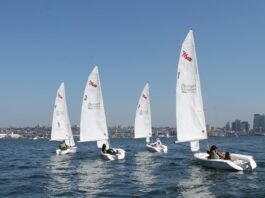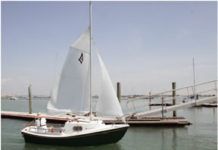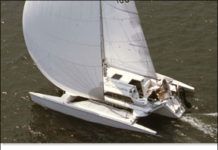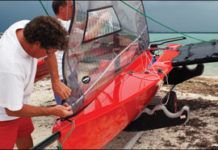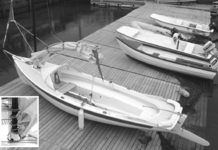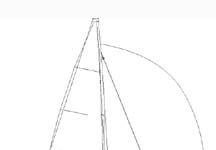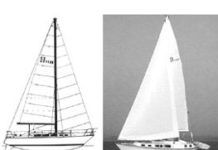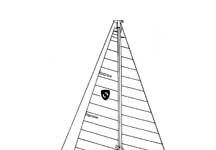EXPO Solar Sailer
The EXPO Solar Sailer was conceived by Hoyt (who has a long list of conceptions to his credit), designed by Hood (who needs no introduction) and built by TPI(at present, or one time or another, the builder of J Boats, Aldens, Jeanneau catamarans and Freedoms). Put Gary Hoyt, Ted Hood and Everett Pearson in a canoe and you have the marine industry's maximum tripartite brain power. The cerebral sparks from these three New England dynamos produced the EXPO Solar Sailer.
Practical Sailor Reviews Seven Performance-Sailing Dinghies
With summer upon us, light, quick sailing dinghies that are easy to sail and easy to transport make summertime on the water a blast. Practical Sailor reviews some of the perennial favorites-the Optimist, Sunfish, Hobie, and Laser-and looks at how newcomers like Bic Sports Open Bic match up. Testers also review a do-it-yourself sailing dinghy kit, the Eastport Pram from Chesapeake Light Craft, and Hobies newest catamaran, the Bravo, a quick-to-launch beach cat with plenty of get-up-and-go. We also take a look at Laser Performances newest club trainer/racer for the wee sailors, the Bug.
Mailport: June 2011
Letters to Practical Sailor, June 2011. This month's letters cover subjects such as: Barnacle Barrier Success, Pump Switches, Antifouling Field Report and more!
Catamarans and Trimarans – a Performance Multihull Report Looking at Speed, Style, and Value
The BMW Oracle teams recent win of the Americas Cup-along with a flood of e-mail from multihull fans-has given us good reason to revisit the performance multihull alternative. In this reader-requested sequel to our Need For Speed monohull report (September 2009), we focus on design features that make multihulls fast and fun to sail, and examine why many feel that two or three hulls are better than one. It quickly becomes obvious that todays boats diverge sharply from the iconic Hobie Cat 16. To really get excited about performance in sailing catamarans and trimarans, lightweight, lean hulls and sizable sail area are a must. In this review we look at five terrific performance multihulls: The Hobie Getaway, Weta Trimaran, Windrider Rave, Corsair Dash 750, and Telstar.
Compact Weta Trimaran Screeches Past the Big Boys on Biscayne Bay
When it comes to the pure love of sailing, its hard to beat a small, light efficient boat whose sole mission is to harness the wind. Designed in New Zealand, built in China, imported to the U.S. by Nor Banks Sailing of Duck, N.C., the 14-foot-6-inch, 220-pound Weta 4.4 trimaran with 158 square feet of sail was conceived in New Zealand by father-and-son team Roger and Chris Kitchen, and designed with collaborative help from a handful of experienced sailors. The challenge was creating a cost-effective boat with the strength-to-weight ratio needed for performance sailing. The boat uses carbon fiber on the framework, and on the mast and sprit while the light, stiff hull structure, daggerboard and rudder are built using less costly E-glass and Divinycell foam. The boomless mainsail, made by windsurfer sailmaker Gaastra, incorporates five full tubular battens that control draft and allow the mainsheet to be attached to a well-reinforced clew rather than a conventional boom. The high-tech Gaastra sail package, like the Harken hardware and carbon sprit and mast are all standards. The success of this pocket-sized trimaran is due in part to its triple threat sailplan of main, jib, and easy-handling, furling screacher. The screacher can add a virtual turbo boost. This 60- square-foot gennaker deploys like any roller furler but is trimmed via a single sheet led through both port and starboard leads. The ride is both exhilarating and responsive.
Norseboat 17.5
This versatile daysailer combines traditional aesthetics with contemporary construction. The downside? A proper jib would make for better tacking.
J/105
The J/105 enjoys an immensely strong class association fueled by a group of owners who wouldn't sail any other way than fast and easily. Problems with the boat are few, and right out front.
S2 11.0
The biggest of the S2 series was offered in two layouts. The center-cockpit version is a bit ungainly looking, but offers a lot below, and like her sister is well-built.
Columbia 9.6
This late '70s coastal cruiser is somewhat plain but structurally sturdy.
Tartan Ten
While we wouldn't consider the Tartan Ten to be one of the better-built racers, she doesn't have to be. Since she is primarily intended to race against her sisters, consistency between boats is perhaps more important than superior (and hence, more expensive) construction. The major construction criterion she must meet is to be sufficiently seaworthy to endure an occasional short offshore race. She meets this criterion, although, like too many production boats, she barely makes it.
































